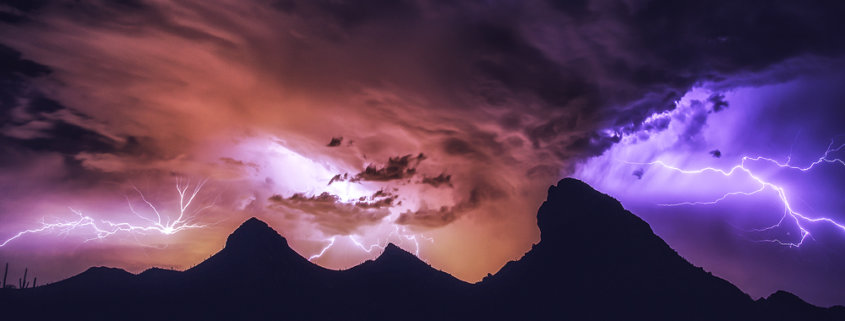Photographing during Rainy Days
As someone who lives in the southwest desert, I know every summer brings the rainy days of monsoons. These can be some of the most intense storms found in the desert as well as many different weather phenomena during this incredible time of the year. Photographing during rainy days in the desert can yield some stunning photos, but there are many things you need to know before searching for that gnarly and dramatic weather image.
Safety
This is a very dangerous time of the year to be outside specially when you are trying photographing during rainy. Many times the temperatures are in excess of 100 degrees. Thunder and intense lightning are common and can strike you or objects close to you during. Flash flooding can leave you stranded. And dust storms (also known as “Haboobs”) can cause driving issues as well as health issues.
You must understand these dangers prior to heading out on your photography shoot, especially if you are not familiar with this kind of weather. I’ve seen and experienced everything with monsoons and, while I haven’t been able to create images of every type of phenomena, I’m fortunate to live in a place that gives me that chance for months at a time.
There are a number of apps that you should have on your phone to help track and follow storms and lightning. Radarscope is a popular one among storm chasers; it is perhaps the most accurate weather radar app out there. Weather bug is also a useful app; it tracks lightning, how close it was, when the last strike occurred, and when it’s time to find shelter.
Be sure to obey signs that note do not enter when flooded. The water may look only a few inches deep which most find manageable. However, oftentimes it is much deeper and filled with debris making it dangerous to cross. There are actually laws in the state of Arizona that make you pay back every penny used to rescue you in such instances.
Use common sense and don’t take chances. If you encounter a dust storm/Haboob while driving, be sure to pull off the road and turn your lights off far from any traffic if possible. Again, use common sense when it comes to weather.
Gear
Now that you have safely made it to your location to photograph, it’s time to take a look in the bag and make sure you have the right gear. Obviously, you need your camera, a lens or two, and a tripod. Typically, your lens range should cover super wide (14mm or similar) to 70mm. Longer focal lengths can come in handy but, from my experience, this range of focal lengths are all I’ve needed.
If you want to photograph daytime lightning strikes, a lightning trigger most definitely comes in handy. You can choose from numerous models in different price ranges, but be sure to read reviews to find the right one for you. Some are more accurate than others. If you are photographing lightning after the sun has set, there is no need for a lightning trigger; just keep firing those long exposures and you are bound to get some.
A sturdy tripod is a must as it can get quite breezy out there, especially when a dust storm is on the way and when photographing lightning after sunset; long exposures require the use of a tripod. Also consider bringing a rain jacket; even on 100 degree days, when it downpours, the temperatures drop and you probably want to stay dry. A rain cover for your camera may also come in handy if it rains heavily or briefly.

Lightning strikes the south rim of the grand canyon as seen from a remote viewpoint on the canyons north rim.
Photography
One of the biggest factors of photographing during rainy days is to be flexible. Storms can fizzle out before they start or they can start without almost any warning. Be prepared to change plans and directions more often than not. You may be in a location that is far away from anything else, so your only hope is for something interesting to occur to photograph. Check the weather for chances of extreme weather to photograph before heading out to remote places or areas you may be staying for a few days.
When photographing lightning, be sure you are not the highest point around and that you have someplace to escape to for shelter if things get too crazy. Because of this, you may not be able to find the composition you are hoping for. Try to get creative and find a composition that works. Lightning is usually the main focus of the image, so no need to get too complex with your compositions. Monsoons can also provide some dramatic lightning and atmospheric conditions. Rainbows and stunning sunset light are not uncommon to see (I see these more out of my backyard than anywhere else… go figure).
The best course of action is to be where the weather is. This optimizes your chances of dramatic images; soon enough you’ll be wanting more and more of the action. Even if you don’t get the most dramatic conditions, don’t fret; even if your skunked with storms, you’re sometimes rewarded with incredible sunsets and even sunrises.

After having a storm disappear in front of us, we were still treated to a stunning sunset in the Arizona desert.
Feel free to share some tips and photos in the comments below.







The saharan desert has haboobs.
The Sonoran Desert has Saguaros and Sandblasters.
sunset point to south mountain,
surprise to stafford,
grand-canyon to puerto penasco!
Great images!
Keep up the good work!
Beautiful and amazing! What talent